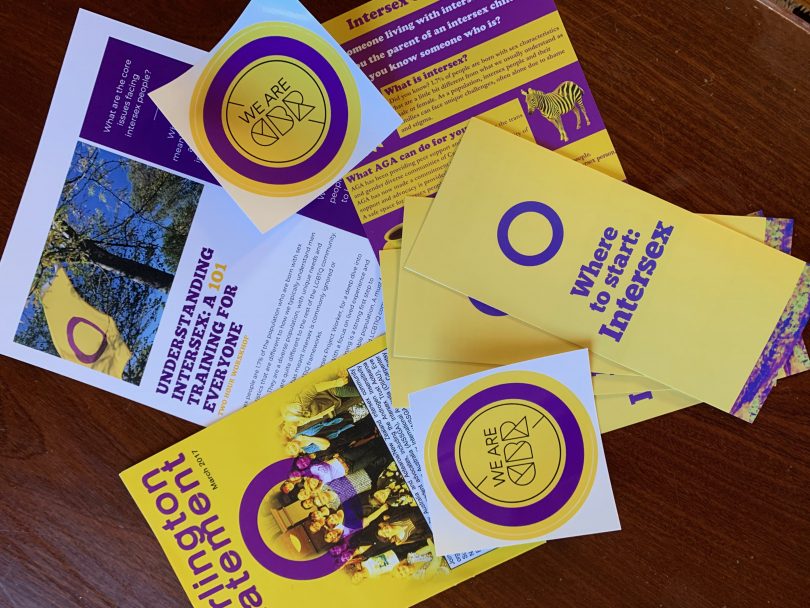
Cody Smith is the Intersex Project Worker at A Gender Agenda. Photos: Supplied.
Pride Month is about many things. It’s a time to reflect on the myriad challenges the LGBTIQ+ community has faced – and continues to face – around the world, a time to celebrate diversity and love, and an opportunity to educate, acknowledge, and grow.
But while Pride flags are raised skyward and traffic signals reflect the uniquely diverse community of Canberra, a marginalised group of individuals often get swept to the sidelines of the conversation. A group whose struggles still reflect the desperate need for enlightened discussion and cultural, social, and legislative reform.
“Most people assume that identifying as intersex is the same as identifying as transgender, and that often conflates the issues,” Cody Smith says. Cody is the Intersex Project Worker at A Gender Agenda, an organisation committed to progressing the rights of Intersex, Trans, and gender-diverse people.
For the past two years, Cody has run an intersex peer support program that provides specialised knowledge and resources on a one-on-one basis, but that program has recently lost its funding.
“The Intersex Project worker position is one of only a few paid positions in Australia, and was originally funded by the Canberra LGBTIQ Community Consortium (the Consortium),” Sel Cooper, executive director of AGA said.
“However, the Consortium’s work finalised early this year, ending the funding for the position.
“AGA has been able to commit finances to the role until December 2019, in the hope to secure further funding for the role.”
However, they are confident they will still be able to manage peer support services for intersex people, and continue to encourage contact.
“I found out I was intersex when I was seventeen years old,” Cody said. “That’s when my parents decided to tell me. My doctor at the time described me as a one-in-a-million case. It took almost ten years before I met another intersex person.”
Intersex people are individuals born with physical sex characteristics that don’t fit the normative medical descriptions of male or female bodies. As an umbrella term, this includes over 40 different intersex variations, spanning anatomical variations, variations in reproductive organs, and even hormonal and chromosomal patterns.
“People who are born with intersex variations embody a huge diversity of gender identities and expressions,” Cody explains. South African athlete Caster Semenya’s recent battle with the Court of Arbitration in Sport is a classic example of how these variations present themselves, and how little the broader community has come to understand them.
And this is a trend that manifests itself, even in the highest echelons of medical authority. Recently, more than 50 intersex-led organisations from around the world issued a joint statement condemning the World Health Organisation’s decision to classify intersex variations as “disorders of sex development” in the International Classification of Diseases 11 (ICD-11).

Several misconceptions prevail with regard to being intersex.
It is this pathologisation of the intersex experience that has caused some of the greatest challenges to the community. Newborns who present physical intersex characteristics are often subjected to surgical procedures in an attempt to ‘normalise’ them. And while this may have been what some parents thought was in the best interest of the child, the fact that surgeries are being performed on bodies that have not consented to it forms the core argument of bodily autonomy for the community.
“The common story we get is usually people coming in telling me ‘I’ve always felt different, I have all these surgical scars and my parents and doctors won’t tell me where I got them from, I think I was born intersex,” Cody said.
“The importance of having a peer support group is so that we can build a supportive environment for the community,” they said. “We have different experiences, different identities, but we are all united by common human rights issues.
“A peer support program can tap into collective wisdom on the subject. It can help people stand up for their rights,” Cody continued.
“Through the program, we encourage good intersex care, bodily autonomy, and consent. We discuss what it means to have or not to have surgery, and we aim to stop non-consensual surgery.”
Cody dedicates 20 hours a week to the program. They said that they have even been approached by parents of intersex children, seeking resources on how best to address the situation.
“It was slow growth at first,” they said. “It took a while to establish trust, but now we have around a dozen individuals in the program each month.
“I suspect that when awareness is raised in the broader community, that number will grow.”

A Gender Agenda supports intersex, trans, and gender-diverse people.
Statistics are hard to come by, especially for individual states and territories. Surgeries to alter anatomical features are not performed in Canberra, so parents take their newborns interstate to Sydney or Melbourne instead. The national statistic is at 1.7 per cent or one in 2000 births, which is an indication that so many are yet to acknowledge or realise that they could identify as intersex. The work Cody does aims to break down those barriers so that more people can come forward.
“It’s about breaking down shame,” they said, “and encouraging internal pride.”
Pride. Being truly comfortable in one’s own skin. We could all use a little more of that in the world.
For more information on A Gender Agenda, visit their website.













